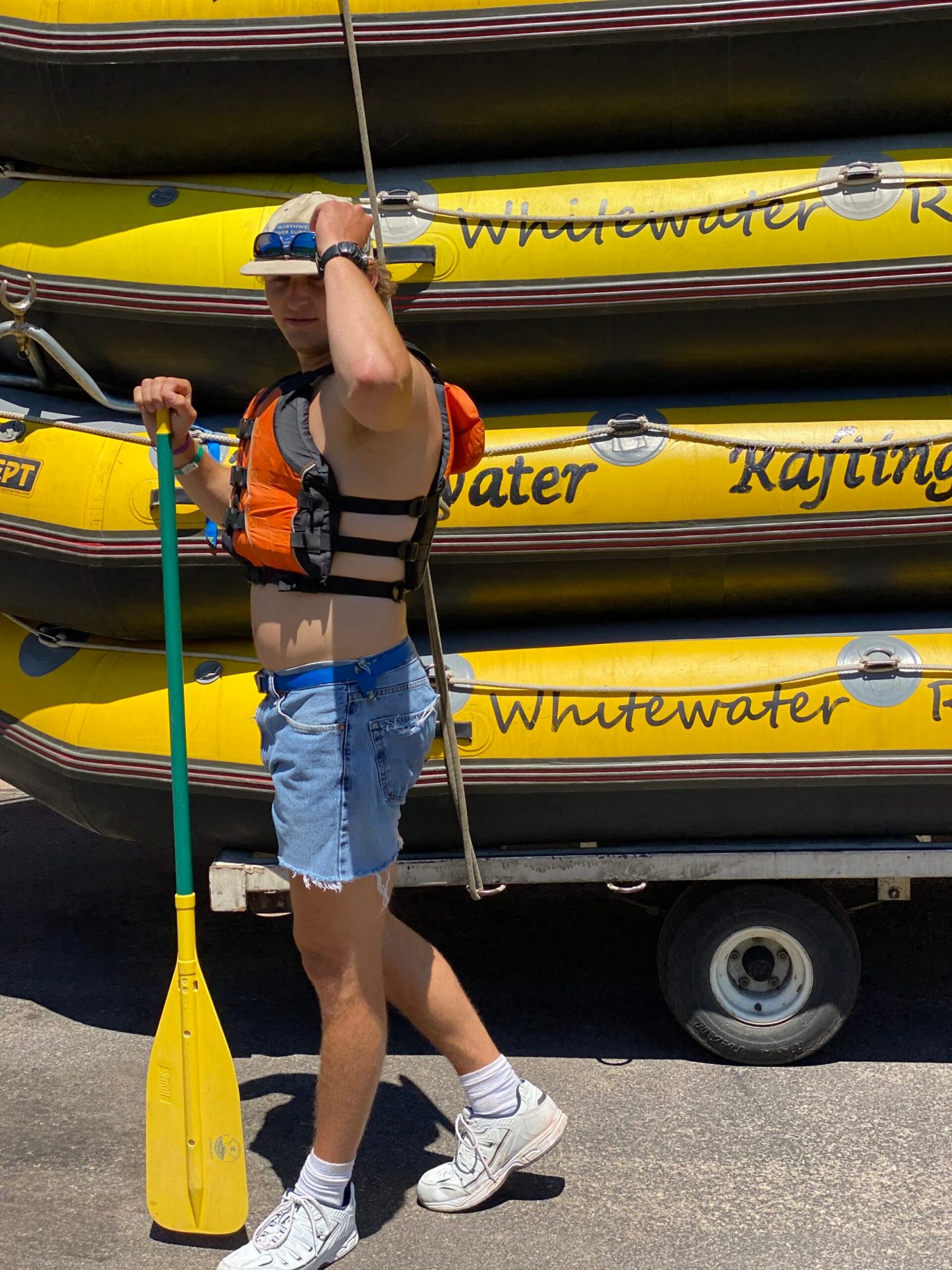What to Wear Whitewater Rafting

Whitewater rafting is a fun summer activity, but what should you wear? When deciding what to wear while whitewater rafting, it’s important to prioritize comfort and safety. Whether a commercial rafting group trip or a leisurely float downstream with friends, selecting garb that will keep you warm, dry, and protected from the sun is essential. You’ll also need sturdy water shoes that support navigating rocky riverbeds, good head protection, and a Personal Flotation Device (PFD) approved by the U.S. Coast Guard.
Still have questions about what to wear for whitewater rafting? Here are a few more tips on how to dress for your rafting trip:

Rafting Clothing Basics
Experts recommend dressing for the water temperature rather than the air temperature when it comes to rafting. If the water temperature is below 70 degrees, you should wear a wetsuit or dry suit and booties. Don’t fret about getting too hot, as the river water can cool you down. Wetsuits and booties are often provided on most commercial rafting trips. You can always call ahead and ask the outfitter if you’re not sure.
These helpful tips will lead you in the right direction:
- Layering is a good idea. It doesn’t hurt to have something to help you stay warm, even on hot, humid summer days, so bring an extra mid or base layer. A warm hat is also a good idea.
- Stay away from cotton clothing as it absorbs water and becomes heavy. Choose clothes made from quick-drying synthetic or wool fabrics. Look for materials like polyester, nylon, or merino wool that can help you maintain a comfortable core temperature and keep you warm even when wet.
- Pro tip: Wear clothes with zippered pockets to store essential accessories like keys, a wallet, or credit cards in the zippered pocket before you go. Trust us, finding your belongings at the bottom of a river is nearly impossible. Make sure to also keep any essential electronics, like your phone and key fob, in a waterproof case.
- Be prepared for the bright mountain sun, and carry plenty of sunscreen. You’re at the mercy of the sun on the water and can feel conflicted when you’re cold. You can also protect your skin with a sun hat, sunglasses, and sunscreen.
- Always wear a life jacket (personal flotation device, PFD) when out of the water. Wear a life jacket every time you get out of the water. Even a little slow-moving water can be dangerous, and shallows are often the most challenging part of a river. Please put on your life jacket and keep wearing it.
Rafting in Warmer Water
If the water temperature is a little warmer, there’s a bit more freedom in what you can wear, but having a few critical items with you is still important. Here are some tips for rafting during the height of summer:
- Wear a swimsuit as the first layer. You will get wet while rafting. Some women prefer to wear a sports bra instead of a regular bikini top. (You’ll find them safer and more comfortable to wear under a life jacket.)
- Wear a quick-drying T-shirt (polyester) over it. Don’t wear cotton T-shirts, as cotton absorbs moisture and dries slowly. If your shirt inevitably gets wet, the cotton will be wet all day and feel heavy.
- Choose something that covers your shoulders and chest for two reasons. The first and most obvious reason is that it protects you from sunburn. The second, less apparent reason is that it prevents chafing and irritation between the skin and the life jacket.
- Wear quick-drying shorts or pants over your swimsuit (not necessary if your swimsuit has a short bottom). Good options include baggy shorts or athletic leggings.
- The rafting company will provide you with a PFD (life jacket) and a helmet.
- Consider tying it up with a braid or two if you have long hair. Ponytails and buns are generally unsuitable for wearing under helmets, and long hair can get caught in helmet barrels or your face in rapids.
The most common question for beginners is, “What shoes do you wear for whitewater rafting?” or “Are you wearing shoes?” Most rafting companies require you to wear shoes on the raft. The best shoes are waterproof sandals with safety straps, like Chacos or Tevas. The strap is vital because it securely holds the shoe to your foot when kneeling on a raft or swimming in the waves. Waterproofing isn’t necessary, but waterproof sandals are more comfortable because they dry quickly, and your feet won’t get soaked afterward.
Rafting in Cooler Water
Most rafting companies do not operate in extremely cold conditions. Dressing for whitewater rafting in cold temperatures is a little different. Here are more ideas on how to dress for cooler rafting:
- In moderately cold weather, rafting companies may provide you with wetsuits. You can wear a wetsuit directly on the swimsuit. They can also provide you with neoprene shoes to keep your feet warm.
- Dry suits differ from wet suits in that they keep all water out and keep you completely dry. They’re made from three layers of material and have latex seals around the wrists and neck to keep water out. They are not very comfortable to wear. Under a dry suit, people usually wear underwear to wick away sweat.
- Shoes are also a little different in cold temperatures. If you do not have and are not equipped with neoprene shoes, please wear a pair of wool socks over your sandals. Wool keeps you warm even when wet.
- If you are equipped with neoprene boots, the rafting company may recommend sandals, as boots have no traction and are uncomfortable to wear on rocks or uneven surfaces. (Also, neoprene is delicate, and rafting companies don’t want them to get holes).
- In very cool temperatures, some people wear neoprene paddling gloves. I like to wear them when it’s cold and rainy. But when it’s not raining, wearing gloves can limit dexterity.
What Not to Wear
Some items are best left on the shore as they are of little use in the river. Here are some helpful tips on what not to wear while whitewater rafting:
- Cotton is one of the most challenging materials to wear while rafting. Cotton naturally absorbs and retains moisture, so after the first splash, you’ll be soaking wet for the rest of your ride and all your lunches. For short rides in warm weather, this might not matter (it might even be refreshing). But in general, I would advise people to stay away from cotton.
- Glasses without temples can be difficult. You might be forced to carry your glasses on the raft if you hate contact lenses. But it’s easy to lose your glasses when splashed by a giant wave or thrown into the water. Before traveling, you can buy a small lanyard to attach to the arms of your glasses so that when the glasses fall off your face, they still hang around your neck (like a lanyard).
- Running shoes are uncomfortable when rafting because they feel muddy and heavy once wet. Swimming with them can also be annoying and potentially dangerous.
- Strapless sandals or flip-flops are not safe. Good luck holding onto them if you end up in the river.
- Before rafting, remove all jewelry except small earrings or necklaces. (At your own risk!)
Other Items to Bring Rafting
We have covered all the basics, but there are a few additional items that can be useful on your rafting adventure. Below are a few other things you can bring rafting to make your trip more comfortable:
- Dry bags are durable plastic bags that are completely waterproof when closed. Most of them have carabiner attachments so that you can attach the dry bag to the boat. If you’re going to be rafting all day, you might want to bring something (like sunscreen, a camera, or snacks). Dry bags are great for keeping these items dry and safe on the raft.
- However, before you buy a dry bag, ask if the rafting company offers a dry bag (many do) or if you can carry one with you on the raft (this should be fine, but it helps to double-check beforehand). There are also different dry bags, but you only need a 5-liter dry bag (minimum size).
- Like the dry bag, bring a water bottle with a carabiner to attach it to the raft.
- Sunlight reflects off the water, so you’re more likely to get sunburned on the water than on land. If you’re going out for a long time, apply sunscreen before you start rafting and pack some in a dry bag.
- Whitewater rafting footage looks great, and you should be able to bring your GoPro to capture the memories. Some helmets have a GoPro mount. Using a rafting company helmet, you can mount the camera on a life jacket or your chest. Be sure to ask your guide before departure.
- Bring a change of clothes after rafting. It’s comforting to have a warm cardigan, dry socks, and slip-ons waiting for you afterward. Many rafting companies have changing rooms (and sometimes showers), so you can change out of your wet clothes and into dry ones before you leave.
- While some rafting companies will provide you with one, bring a towel just in case.
